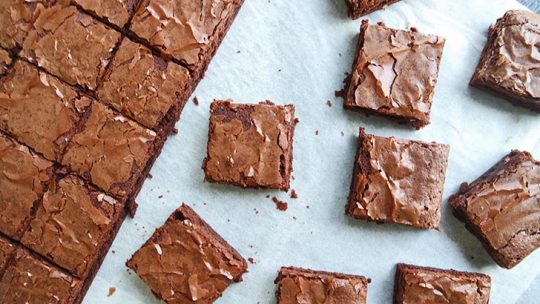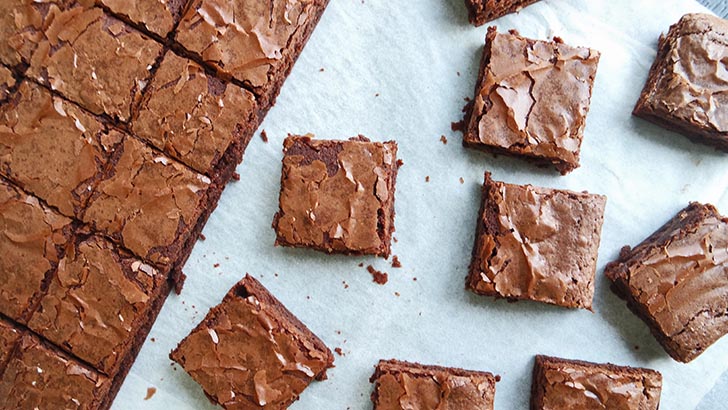Updated on February 9th, 2024
If you’re making brownies and just realized you’re out of vegetable oil, don’t panic. You can still make a delicious batch of brownies — from a mix or from scratch — with other fat substitutes. Some of these substitutes for vegetable oil in brownies will deliver a healthier, more flavorful dessert, too.
Vegetable oil’s role in brownie nutrition
A typical brownie has between 450 and 500 calories, 29 grams of fat, 73 milligrams of cholesterol, 50 grams of carbs, and 6 grams of protein. If you’re following a healthy diet, the numbers there that may concern you are:
- 29 grams of fat represents 44% of the daily value (if you’re eating 2,000 calories per day).
- 73 milligrams of cholesterol is 35% of your daily value.
- 50 grams of carbs is 16% of your daily value.

Choosing the right vegetable oil substitute
Vegetable oil contributes to the fat content of brownies. (Sadly, we can’t blame vegetable oil for the cholesterol or the carbs — those responsibilities fall on the eggs, sugar, and flour.)
Fat is satisfying to eat, and so its presence makes for a richer browner. But the oil does other work, too. It keeps the brownies moist by slowing down gluten formation. This creates a more tender, fluffier texture. Vegetable oil also doesn’t impart a lot of flavor, which allows the main ingredients — usually chocolate — to take center stage.
I mention all this because when you substitute something else for vegetable oil, it can affect the flavor and texture of your brownies. Keep that in mind when you choose an alternative ingredient. Specifically:
- If you want the classic brownie texture, other oils will be your best substitutes for vegetable oil.
- If you want a healthier, lower-fat brownie, you can get it with substitutions — but the texture will change slightly too.
- Some of the substitutes listed below have more flavor than vegetable oil. If you’re not open to experimenting with a slightly different tasting brownie, stick with milder substitutes like canola oil or avocado oil.
Benefits of baking without oil
Swapping out vegetable oil for a lower-fat alternative like applesauce will reduce the fat and calorie content of your brownies. It will also add fiber and nutrients. These are great outcomes, assuming you love the taste of your oil-free brownies.
Note that plant-based oils are generally healthy sources of fat. Still, some believe too much vegetable oil can negatively impact your health. The thinking is that unsaturated fats in vegetable oils can oxidize and lead to inflammation in the body.
Keep these texture, flavor, and health factors in mind as you review these 10 substitutes for vegetable oil in brownies.
Substitutes for vegetable oil in brownies
1. Applesauce
- Natural
- Gluten Free
- Nut Free
- Vegan
- Kosher
Applesauce provides the moisture needed for the easy mixing of the recipe, without the unwanted fat and calories. The big advantage of applesauce as a substitute is that your brownies will be healthier without altering the taste.
The brownies may be slightly drier than you’d expect. You can fix this by adding a bit of water to your batter. Also, start checking for doneness about 5 minutes earlier.
Ratio: Use 3/4-cup applesauce for each 1 cup of vegetable oil. Reduce sugar slightly.
Advantages: Lower fat and more nutritious than vegetable oil. Mild flavor. Will make brownies sweeter.
2. Mashed banana
Mashed banana is another healthy substitute for oil. With ripe, mashed banana, your brownie will be soft, moist, and slightly fluffier. If you’ve ever added mashed banana to pancake mix, you know what I mean here.
As with applesauce, using banana instead of oil could make the brownie drier. Add a couple teaspoons of water to the batter and check for doneness 5 minutes early.
Ratio: Use 3/4-cup mashed banana for each 1 cup of vegetable oil.
Advantages: Lower fat and more nutritious than vegetable oil. Mild flavor.
3. Vegetable puree
No products found.
Staying on the theme of healthier vegetable oil substitutions, you can also try zucchini puree, mashed sweet potato, or canned pumpkin.
Nearly any vegetable puree will do the job, but some vegetables will change the flavor of your brownies. Zucchini will impart a different flavor, but in a good way. Zucchini works better in chocolate brownies, since these two flavors go well together.
Sweet potato and pumpkin are milder and sweeter than zucchini, so the taste difference will be more subtle. These two veggies can give your brownies a slightly cake-y texture.
Ratio: Use 3/4-cup vegetable puree for each 1 cup of vegetable oil.
Advantages: Lower fat and more nutritious than vegetable oil.
3. Cornstarch
- USDA Certified Organic Corn Starch
- Batch Tested and Verified Gluten Free
- Tasteless and Odorless
- Thickens effectively, dissolves easily in soups, sauces, and gravies
- Vegan, Non-GMO, Gluten Free
Cornstarch is an allstar ingredient in the kitchen. You can use it make thick gravies and sauces and as a stand-in for vegetable oil in a pinch. It works best as a substitute in recipes that don’t have lots of oil. Three-quarters of a cup is about the max. More than that and the texture change will be significant.
To swap in cornstarch for vegetable oil in brownies, mix a tablespoon or so with water. Whisk until the mixture is smooth. It goes faster if you do this in a saucepan over heat. Try to mimic the texture of oil — not too runny and not too thick.
Ratio: Use 1/2 cup of cornstarch and water for 1/2 cup of vegetable oil.
Advantages: Lower fat than vegetable oil. Mild flavor.
4. Plain yogurt or sour cream
If you’re open to using a diary substitute in your brownie, try plain yogurt, plain Greek yogurt, or sour cream. You’ll lower your fat content and add protein — two good things!
Neither yogurt or sour cream has a strong flavor, so you shouldn’t notice the substitution in terms of taste. The batter may be thicker than you expect. If it seems too thick, add water a teaspoon at a time until the consistency seems normal. Also check your brownies a few minutes early as they may cook faster.
Ratio: Use 3/4-cup yogurt or sour cream for each 1 cup of vegetable oil.
Advantages: Lower fat and more nutritious than vegetable oil.
5. Almond milk plus melted butter
Another option is to mix almond milk and melted butter into your brownie batter instead of vegetable oil. This combo will add a subtle — and delicious — nutty flavor to your brownies. The butter helps out by providing fat to preserve the traditional brownie texture.
Ratio: Use 3/4-cup almond milk and 1/4 cup melted butter for each 1 cup of vegetable oil.
Advantages: Lower fat and better flavor than vegetable oil.
6. Melted butter
Butter is not a healthier substitute for vegetable oil — but it is a tasty one. Your brownies will be creamier and more buttery (sorry, there’s no other way to describe butter’s unique taste). You may need to bake your brownies a few minutes longer with this substitution.
Ratio: Use 1 cup melted butter for each 1 cup of vegetable oil.
Advantages: Rich flavor and texture.
7. Any other oil
- GREAT FOR COOKING: Our refined avocado oil is the perfect all-purpose cooking oil. It is great for fried dishes, and it makes a nice base for a homemade salad dressing when cold
- EVERYDAY VERSATILITY: This cooking oil is useful for just about anything, making it olive oil’s match in every way. Use it for frying, sauteing, baking, and more
- LIGHT FLAVOR ENHANCER: This useful cooking oil has a subtle and smooth flavor compared to traditional vegetable oil, enhances the flavors of food, and has only 10g of monounsaturated fat per serving
- NO ADDITIVES: No additives: Refined, Non-GMO and gluten-free, this oil contains no additives. Carefully sourced to deliver a clean flavor, this oil is perfect for keto and paleo diets
- EDUCATE YOUR TASTEBUDS: BetterBody Foods products combine better-for-you ingredients with delicious flavor. We are committed to nutritious, wholesome foods made with clean, simple ingredients
Other oils are fabulous substitutes for vegetable oil in brownies. And this makes sense. Oils generally share the same texture and they’re all 100% fat. Here are some oil substitutes to try in your brownies:
- Avocado oil and canola oil will stand in for vegetable oil without any noticeable change in taste.
- Coconut oil will impart flavor to your brownies. If you like chocolate and coconut — like an Almond Joy candy bar — you’ll love this substitution.
- Olive oil, especially extra virgin olive oil, will add a slightly savory flavor to brownies. It’s delicious if you like that sort of thing.
Ratio: Use 1 cup oil for each 1 cup of vegetable oil.
Advantages: No change in texture. Flavor can be the same or enhanced with a different oil.
8. Shortening
Shortening is last on our list of substitutes for vegetable oil in brownies. Oil shortening is basically vegetable oil that has gone through hydrogenation to make it semi-solid.
Mixing will be easier if you heat the shortening slightly first. Don’t dump it into your batter smoking hot, though. You don’t want your eggs to cook before the batter gets in the oven.
Note that shortening contains trans fat, which isn’t good for you. So compared to all our substitutes for vegetable oil in brownies, this one is least healthy.
Ratio: Use 1 cup heated shortening for each 1 cup of vegetable oil.
Advantages: No change in texture or flavor.
FAQs about substitutes for vegetable oil in brownies
Can I replace vegetable oil with mayonnaise in brownies?
Yes, you can. Mayonnaise gives brownies a great taste and texture, similar to yogurt or sour cream. Use 3/4-cup mayo for every 1 cup of vegetable oil.
Can I replace vegetable oil with olive oil in brownies?
Yes, olive oil works nicely in brownies. Expect the taste to be slightly different, though. The savory aspect of olive oil complements a chocolate brownie well.
Can mayonnaise replace eggs and oil in brownies?
Mayonnaise contains eggs and oil, so it works as a substitute for oil or eggs. You may need to add water to your brownie batter if it seems too dry.
Can I use coconut oil instead of vegetable oil in brownies?
Yes, coconut oil makes for a wonderful substitute for vegetable oil in brownies — assuming you like coconut and chocolate together.
You don’t need vegetable oil for your brownies
Whether you’re out of vegetable oil or you want a healthier brownie, you have options. There are eight substitutions here, but you can also mix and match them depending on your taste preferences. A bit of cornstarch and water plus mashed banana, for example, might produce your best brownie ever.
Last update on 2025-07-01 / Affiliate links / Images from Amazon Product Advertising API



